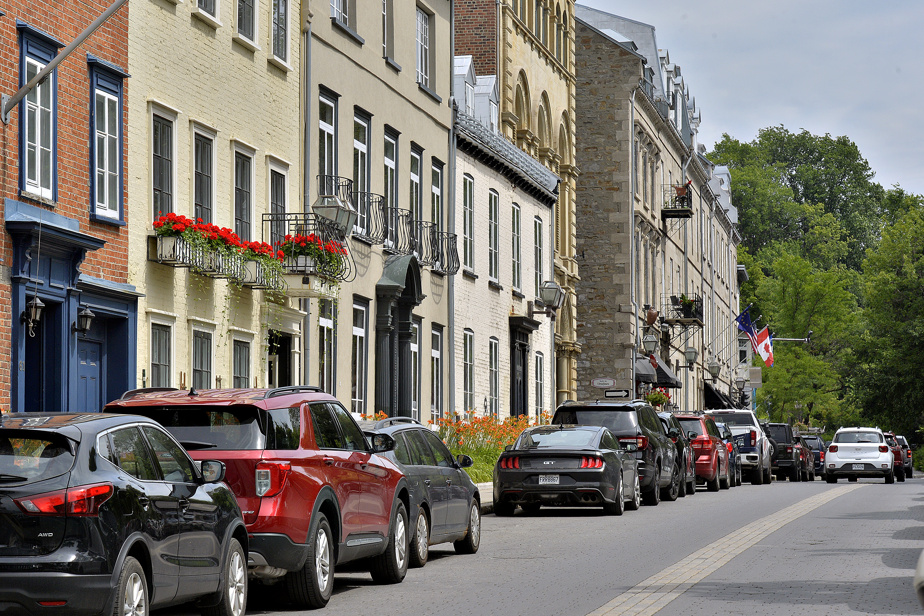(Quebec) Developers in the capital will no longer be required to provide parking spaces in their new projects. The measure adopted Tuesday should stimulate construction and promote sustainable mobility in Quebec, but an opposition elected official fears that it will “force” people to take public transport.
What there is to know
Quebec City has abolished minimum parking ratios on a large part of its territory.
New residential buildings in dense neighborhoods and those in certain areas will no longer have to have boxes.
The real estate industry welcomes the change, which it says will enable housing to be delivered at a lower cost.
“We have the possibility of accelerating housing projects. When we come to say that the storage of vehicles prevents the storage of humans, we must redefine priorities. There, we come to give priority to people, to housing,” said Mayor Bruno Marchand’s right-hand man, Pierre-Luc Lachance, to the municipal council on Tuesday evening.
Until now, a municipal by-law required developers to provide a minimum number of parking spaces. This minimum threshold ranged from 0.5 to 1.2 boxes per dwelling. Developers who did not comply with the standard had to pay compensation to the City.
The new regulation adopted by a majority Tuesday evening provides for the outright abolition of the threshold in the densest parts of Quebec, where public transport options exist.

IMAGE PROVIDED BY QUEBEC CITY
Map of the sectors of Quebec where parking ratios have been abolished.
Only one party, Équipe priority Québec, voted against the modification of the regulations. Quebec lacks parking spaces, claimed Councilor Stevens Mélançon.
“It’s all well and good, promoting public transportation, but we can’t force future tenants to take it,” he said. It’s like saying to a landlord: you can build housing, but future tenants can’t have a car. »
The two other opposition parties supported the modification presented by the administration of Mayor Bruno Marchand.

PHOTO EDOUARD PLANTE-FRÉCHETTE, LA PRESSE ARCHIVES
Claude Villeneuve, leader of the official opposition of Quebec City
If I have the choice between placing people and placing cars, I choose to place people.
Claude Villeneuve, leader of the official opposition
“ Do we want housing or parking? I think the choice is clear,” argued the head of Transition Quebec, Jackie Smith.
About $60,000 for parking
The Urban Development Institute of Quebec (IDU), an organization bringing together major Quebec players in the real estate industry, welcomes the decision of the City of Quebec. The IDU has been asking for a decade for this regulation to be reviewed.
We are at around $60,000 for the underground parking space. This has a significant impact on housing affordability. This allows you to have units at a lower cost.
Stéphane Dion, regional director of the IDU for Quebec
“There are very few cities in Quebec that have made this bet. Quebec would even be the first major city in the province,” says Mr. Dion. In Montreal, certain boroughs have also abandoned parking ratios, including Ville-Marie, Le Plateau-Mont-Royal, Le Sud-Ouest and Côte-des-Neiges–Notre-Dame-de-Grâce. The Plante administration, however, proposes to remove these ratios entirely from its draft 2050 Urban Planning and Mobility Plan, currently under study.
Citizens are concerned about the availability of on-street parking with the new measure. Mr. Dion specifies that abandoning the minimums does not mean that developers will stop building huts overnight. But it will be case by case.
“There is the climate crisis and there is the housing crisis. If we want more housing, and Quebec City wants 80,000 more by 2040, we must remove the obstacles. »
During a recent City public consultation on the regulatory change, a citizen in favor of the change gave a telling example.
“I remember a housing tower project at the Sainte-Foy CEGEP,” the lady said. For 172 housing units on a college campus, the developer had to build 130 parking spaces. When we know that it is students who live there, and that buses pass there, I found it exaggerated. »
